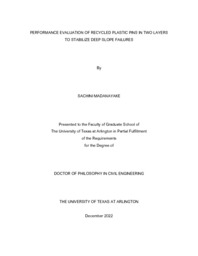
ATTENTION: The works hosted here are being migrated to a new repository that will consolidate resources, improve discoverability, and better show UTA's research impact on the global community. We will update authors as the migration progresses. Please see MavMatrix for more information.
Show simple item record
| dc.contributor.advisor | Hossain, MD Sahadat | |
| dc.creator | Madanayake, Sachini | |
| dc.date.accessioned | 2023-01-26T16:14:35Z | |
| dc.date.available | 2023-01-26T16:14:35Z | |
| dc.date.created | 2022-12 | |
| dc.date.issued | 2022-12-09 | |
| dc.date.submitted | December 2022 | |
| dc.identifier.uri | http://hdl.handle.net/10106/31022 | |
| dc.description.abstract | Slope failures are a common occurrence in highway embankments throughout Texas due to the presence of high plastic clays with expansive behavior. Although shallow slope failures are prevalent, slope failures extending deeper into the slope occur due to the development of micro and macro cracks. The cracks facilitate the infiltration of rainwater deeper into the slope over time. Slope failures incur thousands of dollars’ worth of repairs every year for transportation departments across the country.
Recycled Plastic Pins (RPP) have been identified as an effective, cost efficient, and sustainable solution to stabilize shallow failures. The resistance of RPP is mobilized when the slip surface intersects the reinforcing member. When slip surfaces extend beyond the length of RPP, little to no resistance is mobilized against failure. Hence, a two layered design is proposed in this study to extend reinforcement deeper into the slope as a solution for deeper failures while maintaining the cost and ingenuity of the solution.
The main objective of this study is to investigate the effectiveness of the use of RPP in a two layered design to stabilize deep slope failures. Two sites in Texas were selected to conduct a field study. The sites were reinforced with 10 feet RPP with the first layer installed at the surface of the slope after failure and second layer flush to the ground after backfilling. The reinforcement extended a total of 15-16 feet into the slope. The spacing between the layers was varied in the two sites.
The performance monitoring indicated up to 40% reduction in lateral deformation due the use of the novice design compared to the control section. Vertical deformation results showed that the use of closer spacing between the layers reduced the occurrence of increased surface erosion and creation of rills. Numerical analysis conducted showed up to 15% reduction of deformation at the crest of the slope and up to 45% reduction of deformation at the slip surface due the overlap design compared to conventional design. The study also showed that the factor of safety increased, and the deformation decreased, when the slip surface intersects both layers of reinforcement for failure depths less than 8 feet. However, the anchorage depth takes precedence when the failure planes extend deeper into the slope. Three limiting failure criteria were considered to determine the resistance provided by the reinforcement: Limit soil resistance, limit displacement, and limit flexure. Design charts and prediction models were developed using a modified equation and modeling results. Based on the performance monitoring results and further analysis, it can be concluded that the incorporation of a two layered design is effectively aiding against deep slope failures. | |
| dc.format.mimetype | application/pdf | |
| dc.language.iso | en_US | |
| dc.subject | Slope failures | |
| dc.subject | Recycled plastic pins | |
| dc.subject | Sustainability | |
| dc.subject | Deep slope failures | |
| dc.title | PERFORMANCE EVALUATION OF RECYCLED PLASTIC PINS IN TWO LAYERS TO STABILIZE DEEP SLOPE FAILURES | |
| dc.type | Thesis | |
| dc.date.updated | 2023-01-26T16:14:35Z | |
| thesis.degree.department | Civil Engineering | |
| thesis.degree.grantor | The University of Texas at Arlington | |
| thesis.degree.level | Doctoral | |
| thesis.degree.name | Doctor of Philosophy in Civil Engineering | |
| dc.type.material | text | |
| dc.creator.orcid | 0000-0003-0540-4840 | |
Files in this item
- Name:
- MADANAYAKE-DISSERTATION-2022.pdf
- Size:
- 10.62Mb
- Format:
- PDF
- Name:
- Performance Evaluation of Recycled ...
- Size:
- 147.1Mb
- Format:
- Microsoft Word 2007
This item appears in the following Collection(s)
Show simple item record


